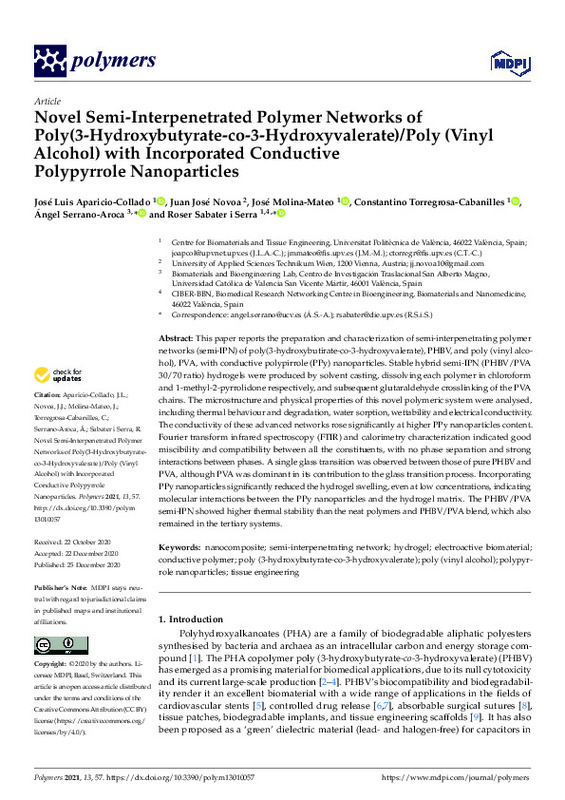JavaScript is disabled for your browser. Some features of this site may not work without it.
Buscar en RiuNet
Listar
Mi cuenta
Estadísticas
Ayuda RiuNet
Admin. UPV
Novel Semi-Interpenetrated Polymer Networks of Poly(3-Hydroxybutyrate-co-3-Hydroxyvalerate)/Poly (Vinyl Alcohol) with Incorporated Conductive Polypyrrole Nanoparticles
Mostrar el registro sencillo del ítem
Ficheros en el ítem
| dc.contributor.author | Aparicio-Collado, José Luís
|
es_ES |
| dc.contributor.author | Novoa, Juan José
|
es_ES |
| dc.contributor.author | Molina Mateo, José
|
es_ES |
| dc.contributor.author | Torregrosa Cabanilles, Constantino
|
es_ES |
| dc.contributor.author | Serrano-Aroca, Ángel
|
es_ES |
| dc.contributor.author | Sabater i Serra, Roser
|
es_ES |
| dc.date.accessioned | 2022-03-23T19:03:18Z | |
| dc.date.available | 2022-03-23T19:03:18Z | |
| dc.date.issued | 2021-01 | es_ES |
| dc.identifier.uri | http://hdl.handle.net/10251/181516 | |
| dc.description.abstract | [EN] This paper reports the preparation and characterization of semi-interpenetrating polymer networks (semi-IPN) of poly(3-hydroxybutirate-co-3-hydroxyvalerate), PHBV, and poly (vinyl alcohol), PVA, with conductive polypirrole (PPy) nanoparticles. Stable hybrid semi-IPN (PHBV/PVA 30/70 ratio) hydrogels were produced by solvent casting, dissolving each polymer in chloroform and 1-methyl-2-pyrrolidone respectively, and subsequent glutaraldehyde crosslinking of the PVA chains. The microstructure and physical properties of this novel polymeric system were analysed, including thermal behaviour and degradation, water sorption, wettability and electrical conductivity. The conductivity of these advanced networks rose significantly at higher PPy nanoparticles content. Fourier transform infrared spectroscopy (FTIR) and calorimetry characterization indicated good miscibility and compatibility between all the constituents, with no phase separation and strong interactions between phases. A single glass transition was observed between those of pure PHBV and PVA, although PVA was dominant in its contribution to the glass transition process. Incorporating PPy nanoparticles significantly reduced the hydrogel swelling, even at low concentrations, indicating molecular interactions between the PPy nanoparticles and the hydrogel matrix. The PHBV/PVA semi-IPN showed higher thermal stability than the neat polymers and PHBV/PVA blend, which also remained in the tertiary systems. | es_ES |
| dc.description.sponsorship | This research was funded by the Spanish Ministry of Science, Innovation and Universities, grant number RTI2018-097862-B-C21, including the FEDER financial support, (awarded to R.S.i.S. and J.M.-M.) and by the Fundacion Universidad Catolica de Valencia San Vicente Martir, grant No 2019-231-003UCV (awarded to A.S.-A.). CIBER-BBN is an initiative funded by the VI National R&D&I Plan 2008-2011, Iniciativa Ingenio 2010, Consolider Program. CIBER Actions are financed by the Instituto de Salud Carlos III with assistance from the European Regional Development Fund. | es_ES |
| dc.language | Inglés | es_ES |
| dc.publisher | MDPI AG | es_ES |
| dc.relation.ispartof | Polymers | es_ES |
| dc.rights | Reconocimiento (by) | es_ES |
| dc.subject | Nanocomposite | es_ES |
| dc.subject | Semi-interpenetrating network | es_ES |
| dc.subject | Hydrogel | es_ES |
| dc.subject | Electroactive biomaterial | es_ES |
| dc.subject | Conductive polymer | es_ES |
| dc.subject | Poly (3-hydroxybutyrate-co-3-hydroxyvalerate) | es_ES |
| dc.subject | Poly (vinyl alcohol) | es_ES |
| dc.subject | Polypyrrole nanoparticles | es_ES |
| dc.subject | Tissue engineering | es_ES |
| dc.title | Novel Semi-Interpenetrated Polymer Networks of Poly(3-Hydroxybutyrate-co-3-Hydroxyvalerate)/Poly (Vinyl Alcohol) with Incorporated Conductive Polypyrrole Nanoparticles | es_ES |
| dc.type | Artículo | es_ES |
| dc.identifier.doi | 10.3390/polym13010057 | es_ES |
| dc.relation.projectID | info:eu-repo/grantAgreement/AEI/Plan Estatal de Investigación Científica y Técnica y de Innovación 2017-2020/RTI2018-097862-B-C21/ES/MICROENTORNOS BIOACTIVOS, ELECTROCONDUCTIVOS Y ANTIMICROBIANOS CON CAPACIDAD DE ESTIMULAR LA REGENERACION OSEA Y PREVENIR INFECCIONES MULTIRRESISTENTES/ | es_ES |
| dc.relation.projectID | info:eu-repo/grantAgreement/UCV//2019-231-003UCV/ | es_ES |
| dc.relation.projectID | info:eu-repo/grantAgreement/ISCIII//CIBER-BBN/ | es_ES |
| dc.rights.accessRights | Abierto | es_ES |
| dc.description.bibliographicCitation | Aparicio-Collado, JL.; Novoa, JJ.; Molina Mateo, J.; Torregrosa Cabanilles, C.; Serrano-Aroca, Á.; Sabater I Serra, R. (2021). Novel Semi-Interpenetrated Polymer Networks of Poly(3-Hydroxybutyrate-co-3-Hydroxyvalerate)/Poly (Vinyl Alcohol) with Incorporated Conductive Polypyrrole Nanoparticles. Polymers. 13(1):1-21. https://doi.org/10.3390/polym13010057 | es_ES |
| dc.description.accrualMethod | S | es_ES |
| dc.relation.publisherversion | https://doi.org/10.3390/polym13010057 | es_ES |
| dc.description.upvformatpinicio | 1 | es_ES |
| dc.description.upvformatpfin | 21 | es_ES |
| dc.type.version | info:eu-repo/semantics/publishedVersion | es_ES |
| dc.description.volume | 13 | es_ES |
| dc.description.issue | 1 | es_ES |
| dc.identifier.eissn | 2073-4360 | es_ES |
| dc.identifier.pmid | 33375726 | es_ES |
| dc.identifier.pmcid | PMC7795713 | es_ES |
| dc.relation.pasarela | S\424666 | es_ES |
| dc.contributor.funder | Instituto de Salud Carlos III | es_ES |
| dc.contributor.funder | AGENCIA ESTATAL DE INVESTIGACION | es_ES |
| dc.contributor.funder | European Regional Development Fund | es_ES |
| dc.contributor.funder | Universidad Católica de Valencia San Vicente Mártir | es_ES |








